All-new Q8 Surprises as More-compact Audi SUV
By John Gilbert
Last week, I wrote about the fun and education offered by the Midwest Auto Media Association’s annual rite of spring — the MAMA Spring Rally — where about a hundred new vehicles are brought to Elkhart Lake, Wis., by manufacturers to be driven by 80-100 auto journalists, who learn how they handle along with experiencing the sheer joy of driving on the best road-racing course in the country.
But getting there was half the fun. My older son, Jack, who assists me with testing and photos, drove up from the Twin Cities so we could leave from Duluth, early on Tuesday, May 21st, for the six-plus-hour drive, zig-zagging diagonally from Duluth, Mn., and down through Wisconsin to Elkhart Lake, in the southeast region just north of Milwaukee.
We drove down there and back in an Audi Q8, which is Audi’s latest and perhaps best SUV. In Audi’s lexicon, cars are designated by “A” as in A3, A4, A5, A6, A7 and A8, and the SUVs by “Q” with the smallest the Q3, then the Q5 midsize and the Q7 as the largest. I am a big fan of vehicles that are as small as they can be while still being big enough, so I assumed the A8 would probably be the biggest, and I would have to subvert my personal feelings into the scope of someone with a need for a huge SUV.
To my pleasant surprise, the Q8 is not only less than huge, it is lower and shorter than the Q7. It shares the design cues, although its familiar grille has been altered to contain much wider gaps in its cross-hatch design. So large, in fact, that I suggested it could let in a lot of air, but might also let in insects as large as sparrows, which could clutter up your radiator.
Next from Audi is the e-tron, a pure-electric SUV with quattro all-wheel-drive and all, and we await a chance to test its driving range. It looks sleek and compact, with the same style grille as the Q8, which for now, is plenty high-tech. It comes in hybrid fashion, which Motor Trend claimed is the only available engine, but our test vehicle came with an alternative — the high-tech turbocharged 3.0-liter V6, which delivers 354 horsepower and 369 foot-pounds of torque in other Audi utility vehicles. It runs through an 8-speed Tiptronic automatic.
I was surprised that the Q8 was not included in the Rally, where we also vote on the Family Car of the Year, and now, with prices rising, a Luxury Family Car of the Year. The MAMA board decrees that only cars made available to be driven at the spring and fall rallies can be considered, whatever the reason for Audi’s exclusion, it’s unfortunate, because the Q8 would have been a definite favorite. Selfishly, though, it didn’t matter, because I got to experience it in real-world conditions and it came through regally.
Listed at a $67,400, which is moderate for a luxury-level SUV, the test Q8 totaled $79,340 once you added on option packages such as Premium Plus, Driver Assistance, the Year One, and Towing. That meant the jump up to 22-inch alloy wheels, plus virtually every driver-assist gadget you’ve ever heard of, to alert drivers to obstacles moving or stationary, ahead, behind or on either side. It will stop short of an obstruction or slow-moving vehicle, and its superb handling from adaptive suspension dampers makes it handle with great, sporty stability.
The test Q8, in its optional Daytona Gray Pearl Effect paint, justifies its luxury price with interior features you appreciate as soon as you see them, such as fine-grain ash inlays on the dashboard, tastefully blended in with aluminum and leather to engulf you in plush comfort, but always with solid support.
It also has Audi’s newest navigation system, and we found it to be both good news and bad news. On the way down it was fantastic, taking us on all sorts of back roads, but always excellent highways. As a Minnesotan, I have to wonder why every Wisconsin road we drove on was smooth and maintained, compared to the pothole-dotted endurance tests of Minnesota highways.
The simplest way from Duluth to Elkhart Lake might be to go straight south on Hwy. 53, then take Interstate 94 east until finding a likely connecting road, or to cut straight east on state roads running above 94. But the quickest way is also the most enjoyable and most fun driving, and it was exactly the way the Audi nav lady directed us. We made it from Duluth into the north end of Elkhart Lake, all 350 miles on one tankful of premium gas, getting about 24 miles per gallon, off an EPA maximum estimate of 22.
It was less perfect two days later on our return trip Thursday afternoon. I anticipated it might vary its guidance because I was going to drop off Jack at his residence just north of St. Paul, but I still wanted to drive on most of the same roads we had come down on. To assure the nav lady wasn’t tempted to guide us quite a distance southwesterly to connect to I-94, we drove off in a northerly direction for 30 miles and then put in our navigation desires.
We made a stop of two, and when we got into our trip, we drove for a solid half-hour before I realized we were being directed by gentle voice commands almost straight south. We wasted an hour getting turned around and trying to figure out how to get back on our preferred route, and about every mile or so the nav lady demanded we make a u-turn and head south. Of course, for safety reasons, even the passenger cannot reset the nav while the car is moving, which it reminded us about whenever we tried to cancel out of it. After four or five stops and resets, we ignored the nav lady and drove northward, until we finally coaxed the system to concede and reconfigure the directions.
Pondering the fun of driving Lexus sports cars, BMWs like the new 3-Series, Mercedes products, hot Mustangs and Shelby GTs, and everything else from Miatas to Hyundai Veloster N, and Challenger Hellcats, the enjoyment was plentiful. But it won’t be diminished with more electrification. I have reached the point of experience where I want to learn about the many high-tech drivability features as to simply go fast.
Off the actual race track, we had off-road and the timed autocross sessions, where more than a dozen vehicles could be hurled around one lap of the tight little paved go-kart track inside the big circuit. We lined up like grade-school kids fighting for position at an ice cream parlor, and when you got up to be first in line, you could defer if you were waiting for a certain car. I did that a couple times, because I wanted to experience everything, including the handling of the comparatively large Maserati Lamonte Trofeo SUV with its surprisingly solid suspension and Ferrari-built powertrain.
I finally got to all of the autocross cars except an elusive dark red BMW M2 coupe that seemed to always be on the course, driven by somebody else. I did get to drive the just-introduced Veloster N, a Mazda3 hatchback, a Miata, a Nissan 370Z, the GTI, GLI, BMW Z4, Durango SRT, Gladiator, Blazer, and about 50 others either on the big track, the surrounding roadways and the autocross, where times were electronically registered and prizes awarded for the quickest laps.
While a few of us wanted to try everything, some picked out what they thought would be the quickest car and drove it repeatedly. The guy who won actually placed first, second and third — and it turned out, all in that same M2. Everyone thought that was a novelty; I thought he missed a lot of other neat cars. And no wonder I couldn’t get even one lap in the M2!
The auto industry is hurtling into the future, and I couldn’t help but wonder how the Rally will be when it becomes mostly populated with electric cars. Assuredly, we will all be driving electrified vehicles before another decade passes. Maybe it will be pure electric, or maybe some form of plug-in hybrid, or straight hybrid, but the free efficiency of electric power that can be self-generated by an engine and offers lightning-quick performance is advancing rapidly.
Last week I named the Acura NSX as the unequivocal best I had ever experienced on the track. That low-slung sports car has three electric motors that work seamlessly with a specially-built 3.5-liter V6, located transversely behind the two seats and ahead of the rear axle, which makes it “mid-engine.” That pays off with handling balance unattainable with front, rear, or all-wheel drive.
The NSX V6 powers the rear wheels, which supply the main thrust in forward acceleration, because of the natural shift of a car’s center of gravity from front to rear during hard acceleration. But while one of the electric motors coordinates everything, the other two each operate one front wheel. You would never know it, because operation is so smooth, but the combined horsepower to all four wheels is 573 from the gas-electric combination.
The advancement of cars has been matched by advances in connectivity, and navigation systems, which are pretty fool-proof these days. The nav on my
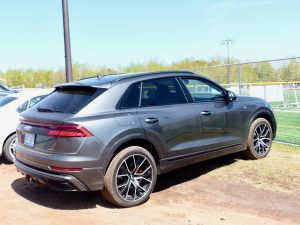
What is as graceful as the styling harmony of the Audi Q8’s rear corner, at a high school baseball tournament game?
iPhone works better than most car systems. But looking back at the almost humorous stubbornness of the Audi Q8’s navigation, it was good to find something to complain about, because otherwise the Q8 was close to perfect.
Lots of power, good fuel economy, comfortable ride, luxurious interior, all housed within an agile, low-slung and attractive SUV that belies its high numerical designation and, hopefully, will be Audi’s guide to a sporty crossover future. If the nav lady fouls up your directions and your trip takes longer, well, that’s just a little more time to enjoy the driving.


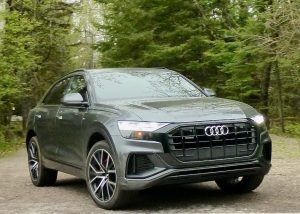
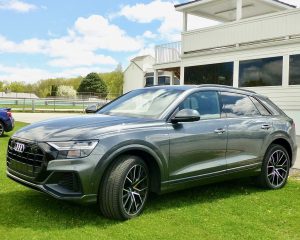
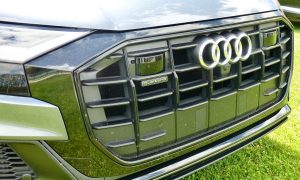
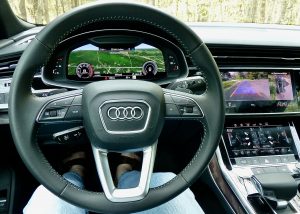
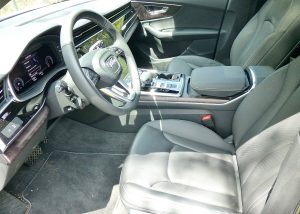
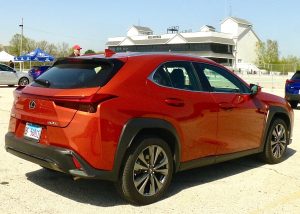
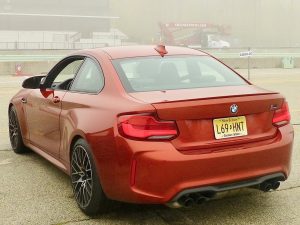
 John Gilbert is a lifetime Minnesotan and career journalist, specializing in cars and sports during and since spending 30 years at the Minneapolis Tribune, now the Star Tribune. More recently, he has continued translating the high-tech world of autos and sharing his passionate insights as a freelance writer/photographer/broadcaster. A member of the prestigious North American Car and Truck of the Year jury since 1993. John can be heard Monday-Friday from 9-11am on 610 KDAL(www.kdal610.com) on the "John Gilbert Show," and writes a column in the Duluth Reader.
John Gilbert is a lifetime Minnesotan and career journalist, specializing in cars and sports during and since spending 30 years at the Minneapolis Tribune, now the Star Tribune. More recently, he has continued translating the high-tech world of autos and sharing his passionate insights as a freelance writer/photographer/broadcaster. A member of the prestigious North American Car and Truck of the Year jury since 1993. John can be heard Monday-Friday from 9-11am on 610 KDAL(www.kdal610.com) on the "John Gilbert Show," and writes a column in the Duluth Reader.